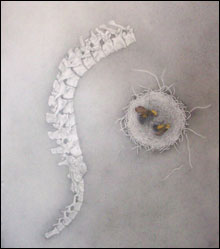
‘BEES’ NEST’ From the Assembled Natural History Series, graphite and watercolor, 11 by 13 inches, 2009, by Susan Drucker. |
Ignore the title: this is less of an "audition" than a cabaret. Each artist here deserves careful consideration, beginning with the window display by Kimberly Convery. Convery is steadfast about her subject — countless little beings swarming mountains and seas — and revisits that scene here. It's a little awkward in the gallery window — her work is always more affective in miniature — but check the "Ascendancy" series inside, where she introduces a new gambit involving ropes dangling from above. One of the gifts of working out a repetitive subject is that the context changes even when the work does not. Even for those familiar with Convery's series, the drawings might suddenly bring to mind "disaster porn," the present-day phenomenon of widespread digital images documenting modern civilization in ruin. While this is clearly unintentional (these drawings continue a six-year series), associations with Japan are inevitable, and it's a worthwhile question whether Convery's drawings, whimsical though they might appear, can summon our empathy better than a YouTube video.Michel Droge sees water through a much different light — little to none at all. The recent MECA MFA grad shows two large paintings, abstract and mostly black, that appear to swallow the gallery's spotlights. Depending on where you stand in the room, the dark field emits different wisps of visible light. Droge's work is gorgeous, and the lustrous expressionist landscapes recall the ethereal fields of local painter Dozier Bell, trading that artist's serenity for a deeper plunge into sublime territory. Things lighten on the opposite wall, where Veronica Cross's paintings depict abandoned terrain in bright tones. Her scenes appear freshly abandoned, still retaining the whiff of human defilement, and her method of affixing cut paper to the canvas gives her subjects a breathing, living quality.
Symmetrical pen-and-inks are never in artistic vogue. Their association with doodles — or worse, the Escher art found in high school geometry classrooms — distance them from most halls of fine art. It's a success, then, that Katherine Benedict's work avoids this association. Her rich drawings make impressive use of the form of the Hindu mandala, though the medium drains the shape of its historically rich color. To be sure, these display incredible precision and monastic patience, but unfortunately for this reviewer, not much else.
Susan Drucker's four drawings are stunning. Dead things and ephemera — segments of rope, inert insects, the bones of mammals — are rendered as if characters in an intimate society. Witness "Bees' Nest," where a fragile spinal column curls around a tiny thicket of dead bees like a mother protecting its kin. Drucker's delicate, expert shading not only marks the frailty of her subjects, but lends a constant presence of warm, diffuse light. Most impressive about this imagery is how fresh it appears; though the characters are familiar (and share similarities with Native American art), their physical, spatial relationships suggest a new, uncoded symbology, like an animal language.